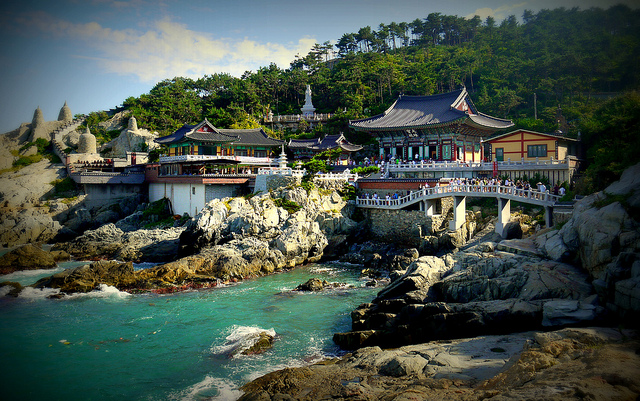A Korean temple as a seaside escape Posted by Tony Kitchen on Apr 4, 2014 in Culture
In Korea, for the weary expatriate, one reaches a breaking point when it comes to Buddhist temples. But Yonggungsa Temple (해동 용궁사) in Busan brings the energy of the sea to land. It’s monks considered it the first place in their world to see the new sun, to see the new year, which is also when this place becomes packed with Koreans, up and down it’s stairs, around its pagodas, along its shores. To be in Yonggungsa is to feel exactly what the builders intended: for man to feel spiritually connected to the sea, an energy force that acts like Man–at times calm, at times unforgivingly ferocious.
Entering the temple, each sign of the Zodiac is represented by roughly two meter stone statues of each sign. The 108 steps, which most temples have, is confused to refer to the 108 volumes of Buddha. But the real meaning derives in the six senses of Buddhism (hearing, sight, taste, touch, smell, and consciousness). Each has three emotions that each sense can bring, multiplied by the two feelings of negative and positive, multiplied by the past, present, and future. That total makes 108 feelings. (The sanskrit word for “statement” can be mistakenly translated as “footsteps.”) In Buddhism, each of the 108 feelings must be overcome in order to achieve nirvana.
The temple, built in 1378, was founded by the monk Naong, a consultant to the king in the legendary Korean city of Gyeongju (경주). During a drought that lead to crops burning and mass famine, Naong had a dream where he was visited by a sea god, one who lives in solitude in the ocean on the back of a great dragon. This sea god told him if he built a temple on the sea at the base of the Bongrae Mountain (봉래산) and prayed there, the drought would end. Visiting the eastern-most part of the sea next to a mountain, Naong saw that the sea was in the front and the mountain was in the back, meaning if he prayed in the morning the answers would arrive in the evening. He named the mountain Bongrae, meaning something pure and mysterious which can be descended even by hermits. He named the temple he built Bomun (보문), which is named after the Buddhist goddess of mercy. The temple was burnt during a Japanese invasion. However, in the 1930s, during a 100-day prayer session, a monk who rebuilt the temple witnessed this goddess of mercy rise in a white robe on the back of a dragon, radiating from a five-color beam. He renamed the temple Haedong Yonggung, coming from the word for thaw (해동) and Yonggung (용궁)–the Palace of the Dragon King.
When I last visited in 2011, coal tiles were available where one could write prayers and eternal wishes. The tiles were placed on the newly renovated rooftops. Beyond the views, the reason the temple is so important for those who seek solitude and peace and the path towards nirvana is that it is said at least one of their wishes will be answered.
The feeling of solitude is immense at Yonggungsa. It’s the energy of the New Year sunrise for many. It’s the story and the monks who created it. But even for the non-Buddhist, it might be the first place where overcoming the 108 feelings in order to achieve nirvana, more than any other temple, feels like a practical life goal.

Build vocabulary, practice pronunciation, and more with Transparent Language Online. Available anytime, anywhere, on any device.





Comments:
Andrew Eagle:
Nice article and introduction to an interesting place.